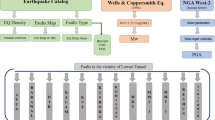Abstract
The town of Edessa is located on Northern Greece at a region that is characterized as low seismicity zone due to the fact that few moderate events of M < 6 occurred during the last century. According to the Greek Seismic Code, the expected acceleration having a 10% probability of being exceeded in 50 years is equal to 0.16g. However, an amplification of ground motion is likely to occur due the local geology that is consisted of Holocene fluvio-torrential deposits. The basic aim of this paper is to evaluate the site amplification due to geological conditions and to assess the liquefaction hazard. In order to achieve this, 1-D site response analyses were performed. The data that were employed for the construction of the numerical models have been collected from borings with standard penetrations tests (SPT) that were drilled for construction purposes. Afterward, the liquefaction potential of the subsoil layers was evaluated taking into consideration two seismic scenarios. The first scenario was based on the seismic parameters, earthquake magnitude and PGA, assigned by the Greek Seismic Code. On the second seismic model, we employed the values of acceleration, resulted from the 1-D analyses and the earthquake magnitude as it was defined by the Greek Seismic Code. In order to compile the liquefaction hazard maps, we initially estimated the liquefaction potential index (LPI) of the soil columns using the parameters provided by SPT, for both seismic loadings, and afterward we correlated these values with the proposed classification of the severity of liquefaction-induced deformations. In addition, having computed the value of probability based on the LPI, liquefaction manifestations probability maps were compiled for both scenarios. The result of this study was that liquefaction-induced ground disruptions are likely to occur at the center of the city, among the branches of Voda River, only when the amplified values of acceleration are taken into account to the computation of liquefaction potential.











Similar content being viewed by others
References
Anastasiadis A, Raptakis D, Pitilakis K (2001) Thessaloniki’s detailed microzoning: subsurface structure site response analysis. Pure Appl Geophys 158:2597–2633
Ansal A, Tönük G (2007) Source and site factors in microzonation. In: Pitilakis KD (ed) Earthquake geotechnical engineering. GGEE6, Springer, Dordrecht, pp 73–92
Bardet J, Ichii K, Lin C (2000) EERA a computer program for equivalent linear earthquake site response analysis of layered soil deposits. WWW document URL, University of Southern California, p 38
CDMG (1999) Guidelines for analyzing and mitigating liquefaction hazards in California. California Dept Conservation, Division of Mines and Geology, Special Publication 117, p 63
EAK (2000) Greek seismic code, earthquake planning & protection organization, Athens–Greece, pp 72 and 7 Appendixes (in Greek)
ITSAK (1991) The earthquake of Griva, 21st December 1990. Report ITSAK: 1991–2001, p 68 (in Greek)
Iwasaki T, Tokida K, Tatsuoka F, Watanabe S, Yasuda S, Sato H (1982) Microzonation for soil liquefaction potential using simplified methods. In: Proceedings of the 3rd International Conference on microzonation, Seattle 3: 1310–1330
Liao S, Whitman RV (1986) Overburden correction factor for SPT in sand. J Geot Eng ASCE 112(3):373–377
Mercier JL (1968) Etude géologique des zones internes des Hellénides en Macédoine centrale (Grèce). Ann Geol Pays Hell 20:1–792
Mercier JL, Vergely P (1984) Geological map of Greece in 1:50.000 scale. Map sheet Edessa. Institute of Geology and Mineral Exploration, Athens
Papas K, Stefanouri M (1989) Processing of geotechnical data of subsoil of Edessa. Thesis, Thessaloniki, p 85 (in Greek)
Papathanassiou G (2008) LPI-based approach for calibrating the severity of liquefaction-induced failures and for assessing the probability of liquefaction surface evidence. Eng Geol 96:94–104
Papazachos BC, Papazachou K (1997) The earthquakes of Greece. Ziti Publications, Thessaloniki
Papazachos BC, Comninakis PE, Scordilis EM, Karakaisis GF, Papazachos CB (2007) A catalogue of earthquakes in the Mediterranean and surrounding area for the period 1901–2006, Publ Geophys Laboratory, University of Thessaloniki. http://geophysics.geo.auth.gr/ss/CATALOGS/seiscat.dat
Pavlides S, Mountrakis D (1985/1986) Neotectonics of the Florina–Vegoritis–Ptolemaida Neogene basin (NW. Greece): an example of extensional tectonics of the greater Aegean area. Ann Geol Pays Hell 33(1): 311–327
Pavlides S, Mountrakis D, Killias A, Tranos M (1990) The role of strike-slip movements in the extensional area of Northern Aegean (Greece). A case of transtensional tectonics. Ann Tect 4(2):196–211
Pavlides S, Valkaniotis S, Chatzipetros A (2007) Seismically capable faults in the Aegean region and their use in seismic hazard assessment. In: Proceedings of 4th International Conference on Earthquake Geotechnical Engineering, Thessaloniki, 2007
Seed HB, Idriss IM (1971) Simplified procedure for evaluating soil liquefaction potential. J Soil Mech Found Div ASCE 97(SM9):1249–1273
Seed HB, Tokimatsu K, Harder LF, Chung RM (1985) The influence of SPT procedures in soil liquefaction resistance evaluations. J Geotech Eng Div ASCE 111(12):1425–1445
Seed RB, Cetin KO, Moss RES, Kammerer AM, Wu J, Pestana JM, Riemer MF, Sancio RB, Bray JD, Kayen RE, Faris A (2003) Recent advances in soil liquefaction engineering: a unified and consistent framework. In: Proceedings of 26th annual ASCE L.A. Geotechnical Spring Seminar, Long Beach, California, 71 pp
Stiros SC (1998) Historical seismicity, palaeoseismicity and seismic risk in Western Macedonia, Northern Greece. J Geodyn 26:271–287
Youd TL (1998) Screening guide for rapid assessment of liquefaction hazard at highway bridge site. Technical report, MCEER-1998–2005, p 58
Youd TL, Perkins DM (1978) Mapping of liquefaction induced ground failure potential. J Geotech Eng Div ASCE 104(4):433–466
Youd TL, Idriss IM, Andrus RD, Arango I, Castro G, Christian JT, Dobry R, Finn WDL, Harder LF, Hynes ME, Ishihara K, Koester JP, Liao SSC, Marcurson WFIII, Marti GR, Mitchell JK, Moriwaki Y, Power MS, Robertson PK, Seed RB, Stokoe KHII (2001) Liquefaction resistance of soils: summary report from the 1996 NCEER and 1998 NCEER/NSF workshops on evaluation of liquefaction resistance of soils. J Geotech Geoenv Eng ASCE 127(10):817–833
Author information
Authors and Affiliations
Corresponding author
Rights and permissions
About this article
Cite this article
Papathanassiou, G., Valkaniotis, S. Liquefaction hazard mapping at the town of Edessa, Northern Greece. Nat Hazards 53, 109–123 (2010). https://doi.org/10.1007/s11069-009-9412-1
Received:
Accepted:
Published:
Issue Date:
DOI: https://doi.org/10.1007/s11069-009-9412-1




